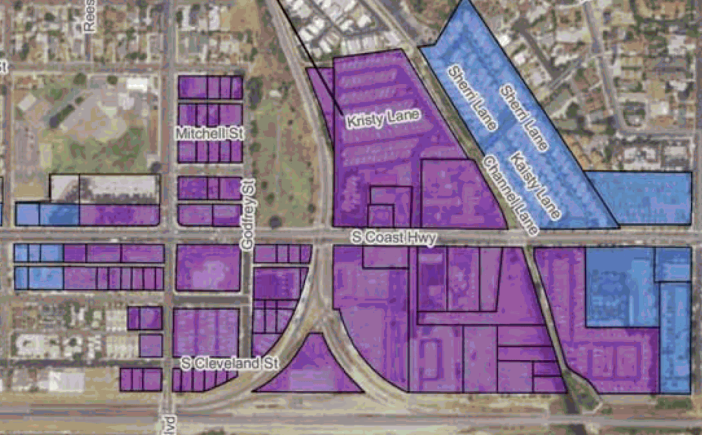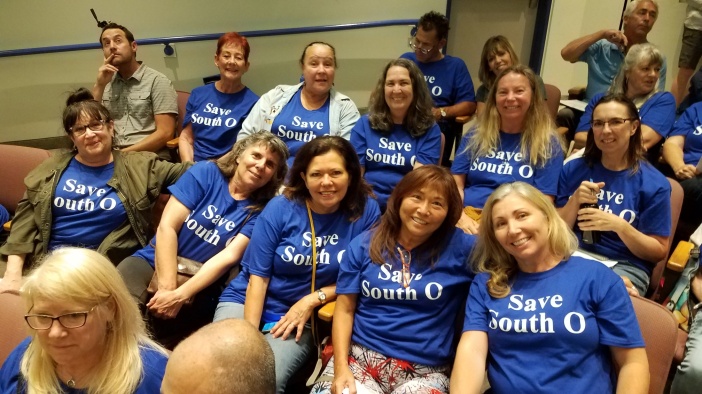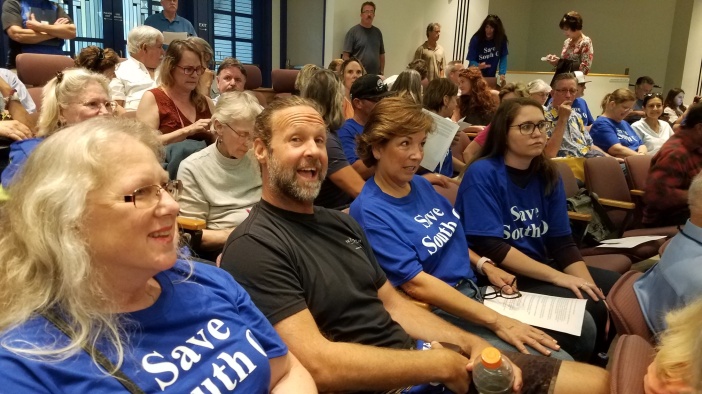On Wednesday, the council voted to move ahead with the proposed Coast Highway plan, largely ratifying the June 10 Planning Commission decision. This was the culmination of the “Coast Highway Vision” process begun in 2007.
In response to public pressure, the hearing was moved from 2pm to 6pm. Fewer South O representatives were able to make it than on June 10, while more supporters of the Road Diet showed up.
Thanks to efforts by our PR advisor, the hearing was filmed by TV cameras (and stories) from Channel 5/69 (KSWB), NBC 7/39 (KNSD) and KUSI 9/51. The Save South O perspective was featured in the KSWB story, as well as a pre-story by KNSD
Council Decision
The Road Diet supporters from Seaside and environmental groups testified in favor of the PC decision, for a Road Diet (with traffic circles) from Morse Street north. South O representatives asked that the Road Diet end at Oceanside Blvd.
A motion to create a Road Diet citywide by Councilman Rodriguez failed for the lack of a second. Then Mayor Weiss made a motion to create an Incentive District from Morse to Seagaze — with a decision on a Road Diet to be postponed until later. Although that motion was seconded by Councilman Keim, it was withdrawn in light of opposition by Rodriguez.
Rodriguez then motioned to approve Alternative 3, seconded by Weiss, and it was approved by a 4-1 motion (Councilwoman Sanchez opposed). Throughout the discussion, Councilman Feller expressed the strongest opposition to the Road Diet.
With the decision, the city will
- Create an Incentive District from Seagaze south to Morse St.
- Add crosswalks at Whaley and Kelly in South O
- Keep the existing Road Diet for the half mile from Morse to Oceanside Blvd
- Add a new Road Diet for almost 2 miles, north from Oceanside Blvd. north to Harbor Drive.

The proposal would also add traffic circles at seven intersections in the Road Diet:
- Coast Highway & State Route 76
- Coast Highway & Civic Center Drive
- Coast Highway & Pier View Way
- Coast Highway & Washington Avenue
- Coast Highway & Wisconsin Avenue
- Coast Highway & Michigan Avenue
- Coast Highway & West Street
Intersections at Mission and Oceanside Blvd. will remain signals, because (according to the city’s studies) they have too much traffic for a traffic circle.
This is a great improvement since Save South O began organizing opposition nearly three years ago, even if it leaves the Road Diet in place in the “Dip” between Morse and Oceanside Blvd.
Potential Changes
The council also approved (4-1) a second motion by Keim — to study removing the Road Diet from the Dip. (The three Environmental Impact Reports never studied this option, which was the one repeatedly requested by South O representatives).
The staff was directed to study the impacts of Alternative 3 but with no Road Diet south of Oceanside Blvd. After that study is completed, the council would then vote whether to adopt this approach, or keep this week’s plan (Alternative 3) unmodified.
This was an encouraging outcome, but South O residents and merchants will need to voice their support for this option once it returns to the council. Save South O will keep everyone posted.

 Public records show that the Node properties around the Sprinter station total 38.69 acres. This would allow 2,437 new dwelling units — in addition to any residential development in the (blue) “Avenue” properties, which allow all-residential projects up to 45’ high.
Public records show that the Node properties around the Sprinter station total 38.69 acres. This would allow 2,437 new dwelling units — in addition to any residential development in the (blue) “Avenue” properties, which allow all-residential projects up to 45’ high.


 Today the city is considering four Alternatives (
Today the city is considering four Alternatives (



 A major aspect of the Coast Highway plan is creating a “Development Incentive Overlay”. The major aspects of
A major aspect of the Coast Highway plan is creating a “Development Incentive Overlay”. The major aspects of